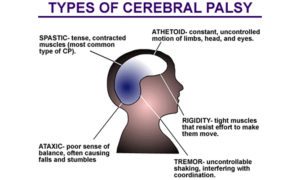[su_divider top=”no” style=”double” divider_color=”#952524″ link_color=”#952524″ size=”2″ margin=”10″]
What is Cerebral Palsy? How to manage it? What are the precautions to be taken? What are the signs and symptoms? What is the cause of this disease? How to treat it? How can homeopathy help you? All of this answered, in this post and of course our doctors always there to help you. Just fill in your details in the form down below and we will answer all your questions for FREE!
[su_divider top=”no” style=”double” divider_color=”#952524″ link_color=”#952524″ size=”2″ margin=”10″]
[sc name=”query”]

What is Cerebral Palsy?
Cerebral palsy (CP) is caused by damage to the developing brain that deranges the brain’s ability. It causes problems with posture, gait, muscle tone and coordination of movement.
People suffering from this disorder may have difficulty with swallowing and commonly have strabismus. They may have a reduced range of motion due to muscle stiffness.
The word cerebral refers to the area of the brain that is affected, while palsy means complete or partial muscle paralysis, accompanied by loss of sensation and uncontrollable body movements or tremors.
Who is more prone to get affected by cerebral palsy?
Individuals of any race can suffer from the disorder. Lower socioeconomic status and male sex may be at higher risk for CP.
Who is more prone to get affected by cerebral palsy?
Individuals of any race can suffer from the disorder. Lower socioeconomic status and male sex may be at higher risk for CP.
What is the causative factor Of Cerebral Palsy?
Congenital cerebral palsy due to brain injury during a fetus development in the womb. It is present at the time of birth, however, it may not be detected for a long time.
What are Maternal risk factors for cerebral palsy?
• Maternal thyroid disorder, especially iodine deficiency
• Maternal seizure disorder
• Maternal severe proteinuria or high blood pressure
• Congenital malformations in the fetus
• Bleeding in the third trimester
• Intrauterine growth retardation
What are the Perinatal risk factors of Cerebral Palsy?
• Prematurity
• Chorioamnionitis
• Birth asphyxia
What are the Postnatal risk factors of cerebral palsy?
•Infections (for example meningitis, encephalitis)
•Intracranial hemorrhage
•Hypoxia-ischemia (example from meconium aspiration)
•Persistent pulmonary hypertension of the newborn
How Cerebral Palsy Is Classified Into Different Types?
Spastic cerebral palsy
Spastic CP is the most common type. A person with spastic CP develops stiff muscles in some parts of the body that are unable to relax. Affected joints become hard to move.
Athetoid (extrapyramidal) Cerebral Palsy
It is characterized by a mixture of hypotonia and hypertonia, which causes muscle tone to fluctuate. The main feature is the involuntary movement in the face, torso, and limbs.
Ataxic Cerebral Palsy
Ataxia is a condition that describes problems with balance and coordination. It is caused by damage to the cerebellum, which controls balance and coordination. People with ataxic CP may have tremors and a reduction in muscle tone.
Mixed Cerebral Palsy
When more than one type of cerebral palsy is present.
What are various signs and symptoms of Cerebral palsy?
Symptoms Of Cerebral Palsy According To Different Types:-
Spastic cerebral palsy
Common signs and symptoms of spastic CP include:
• Awkward reflexes
• Stiffness in one part of the body
• Contractures
• Abnormal gait
Athetoid (extrapyramidal) Cerebral Palsy
Common signs and symptoms of athetoid CP include:
•Stiff or rigid body
•Floppiness in the limbs
•Problems with posture
Ataxic Cerebral Palsy
Common signs and symptoms of ataxic CP include:
•Difficulty speaking
•Problems with depth perception
•Tremors
•Spreading feet apart when walking
Which Test Helps To Diagnose cerebral palsy?
Other conditions may have similar symptoms and need to be ruled out, such as a tumor or muscular dystrophy.
The investigations are :-
•Blood tests
•Cranial ultrasound
•MRI (magnetic resonance image) scan
•CT (computed tomography) scan
•An electromyogram (EMG)
What Treatment is advised in cerebral palsy?
Most of the children go on to lead a near-normal adult lives if their disabilities are properly managed. The sooner the treatment starts, the chances of children having better lives are higher have of overcoming developmental disabilities or learning new ways to accomplish the tasks that challenge them.
Physiotherapy can maintain or improve muscle strength, balance, and motor skills, and prevent contractures.
Occupational therapy helps in upper body function, improving posture, and improves mobility.
Speech therapy can improve a child’s ability to speak, more clearly, help with swallowing disorders, and learn new ways to communicate.
Drug Treatments
Medications like diazepam, baclofen, dantrolene sodium, and tizanidine.
Surgery
Orthopedic surgery is advised when spasticity and stiffness are severe enough to make walking and moving about difficult or pain stacking.
Surgery to cut nerves. Selective dorsal rhizotomy.
What is Differential diagnosis of Cerebral Palsy?
•Inherited Metabolic Disorders Overview
•Intellectual Disability
•Metabolic Myopathies
•Metabolic Neuropathy
•Traumatic Peripheral Nerve Lesions
•Tumors of the Conus and Cauda Equina
•Vascular Malformations of the Spinal Cord
What is Prognosis of cerebral palsy?
Proper therapy can result in many people with cerebral palsy leading near-normal lives. There is significant improvement.
What are commonly indicated Homeopathic remedies of cerebral palsy?
Benzinum Dilithium
Gelsemium Sempervirens
Ginko Biloba
Hypericum
Lathyrus
Nux Vomica
For more information, you can visit Wikipedia and MayoClinic.
Cerebral Palsy
[su_divider divider_color=”#952524″ link_color=”#952524″ size=”2″ margin=”10″]
[sc name=”know-your-doctor”]
[sc name=”more-links-diseases”]

